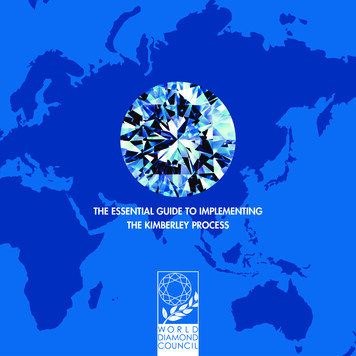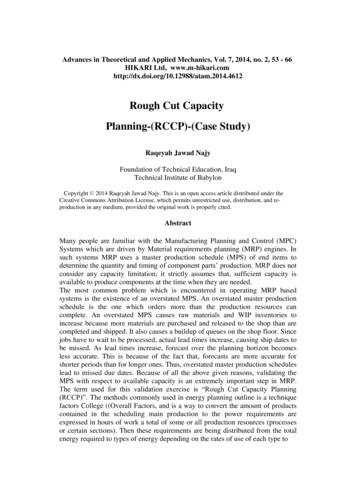
Transcription
Distressed debt & special situationsJune 2019 privatedebtinvestor.comDiamonds in the roughMaking the most outof uncertain times
THE MISSING PIECETHAT COMPLETESYOUR FINANCIALSTRATEGY.WWW.KARTESIA.COMBRUSSELS FRANKFURT LONDON LUXEMBOURG MADRID PARISCreditfluxInvestment of the Year2018Manager Awards 2018Lower Mid-Market Lenderof the Year, Europefollow us on
ContentsHow to contact usSenior EditorAndy Thomsonandy.t@peimedia.com, 44 20 7566 5435Special Projects EditorAndrew Woodmanandrew.woodman@peimedia.com, 44 20 3862 7494Americas EditorAndrew Hedlundandrew.h@peimedia.com, 1 212 633 2906News EditorJohn Bakiejohn.b@peimedia.com, 44 20 7566 5442ReportersAdalla Kimadalla.k@peimedia.com, 852 2153 3874Rebecca Szkutakrebecca.s@peimedia.com, 1 646 795 3270ContributorsDavid Turner, Alicia Villegas, Aaron WoolnerManaging Editor, Production: Mike SimlettHead of Production: Greg RussellProduction Editors: Daniel Blackburn,Adam KoppeserCopy Editor: Eric FishHead of Design: Miriam VysnaISSN 2051-8439 ISSUE 064 JUNE 2019InsightWhere the dry powder goes nextStuart Mathieson, head of Barings’ globalspecial situations investments group inLondon, and Bryan High, co-portfoliomanager for the global special situationsstrategy in the US, discuss the outlookfor distressed debt investing142Five perspectives The industry sharesits thoughts on the leading trends indistressed debt and special situationsYear in review The biggest distresseddebt stories reported by PDI over thepast 12 months4Editor’s letter The importance ofselectivity in uncertain times6Senior Designer: Lee SoutheyDesigners: Denise Berjak, Carmen Graham,Glen ReynoldsHead of Marketing SolutionsBeth Piercybeth.p@peimedia.com, 44 20 7566 5464Subscriptions and reprintssubscriptions@peimedia.comCustomer Servicecustomerservices@peimedia.comEditorial Director: Philip BorelDirector, Digital Product DevelopmentAmanda JanisDirector of Research and Analytics: Dan GunnerManaging Director, Americas: Colm GilmoreManaging Director, Asia: Chris PetersenGroup Managing Director, Brands and Markets:Paul McLeanChief Executive: Tim McLoughlinAnalysis8Where to ramp up in a slowdownDavid Forbes-Nixon, co-founder, chairmanand chief executive at Alcentra, and EricLarsson, co-portfolio manager of thespecial situations team, discuss energy,retail and other opportunities amideconomic strainEuropean regulators reflect ondistress EU member states are graduallyharmonising insolvency and restructuringregimes. Depending on the jurisdiction,private debt investors may benefit10Is there a strong case for litigationfunding? As investors assess lesserknown assets to meet their investmentneeds, litigation funders are witnessinga surge of interest. But how appealingare the returns, given the risks in thisdeveloping market?16Why ‘distress’ does not alwaysequal ‘risk’ Kartesia Capital founderJaime Prieto explains where the futureopportunities lie for distressed debtand special situations in Europe18Eastern approaches Investors, bothoffshore and domestic, are increasinglylooking at how they can ride therising tide of Asian opportunities20Patience and persistence in AsiaPacific Johnson Har, head of Hong Kongat Alter Domus, Kevin Williams, headof operations, Asia-Pacific, and JayeshPeswani, relationship manager for AsiaPacific, offer their perspectives on specialsituations in the region22Will debt for UK retail property dry up?Values are falling, forcing lenders toquestion their exposure to the sector 24Data roomFor subscription information visitprivatedebtinvestor.com28A global strategy PDI data show thatdistressed debt remains a predominantand widespread theme for the asset classfollowing its 2017 peakJune 2019 Distressed Debt & Special Situations 1
Five perspectives The industryshares its thoughts on the leadingtrends in distressed debt andspecial situationsIn recent years, investors havebecome increasingly concernedthat many traditional growthassets, like developed marketequities, are hovering near alltime highs. At the beginning ofMay, the S&P 500 hit 2,945, double thelevel of January 2013, while the MSCIWorld Index, was near its all-time recordset in January 2018. Meanwhile, lowyields from income assets are frustratinginvestors who require a certain level ofreturns to meet their liabilities.2Private Debt Investor June 20191More moneyis arrivingThese two trends have already directedinvestors to look at alternative assets, butthe prospect of an economic downturnhas stimulated interest in distressed debtand special situations opportunities.“In this environment, where yields aregenerally low and many asset classesseem at, or near fully-valued levels,we find there is strong appetite fordistressed debt globally, including in theUK and Europe,” says Brad Bauer, partnerand deputy chief investment officer atVärde Partners.Bauer explains that there has been abuild-up of corporate leverage in Europeand investors have been increasinglymindful of headlines suggestinggeopolitical headwinds and the prospectof additional economic distress.2Fund managers are underscrutiny3New launches areeverywhereHowever, with lots of new money arrivinginto the sector, experts are warninginvestors to scrutinise the skillset oftheir chosen fund manager. JPMorganadvises investors to look for “continuity”and “experience” along with “strongsourcing networks” to find top notchopportunities.Prior to the global financial crisis in2007, real estate managers faced asimilar problem. The arrival of large sumsof cash in quick succession forced somemanagers to deploy cash too quickly inassets they didn’t fully scrutinise. Whenthe crash happened, some saw theirfunds wiped out.One of the upsides of greater investorinterest in distressed debt is that there arean ever-increasing number of funds tochoose from.Since the start of 2019, there havebeen new launches or fundraisings from ahost of major players including Cerberus,Contrarian Capital, Ninepoint and SafeHarbor Equity.“There is a huge amount of drypowder chasing deals,” explains DavidAmpaw, a partner at DLA Piper. “There ishuge demand for distressed debt acrossEurope. The proof of this is evidenced inthe multibillions raised by a number of
The most recent peak in distressed debt fundraising was in 2017, with 66bn raised across 40 fundsCapital raised ( bn)Number of funds 0172018Q1 2019Source: PDIregular distressed debt investors as wellas by newer entrants.”4Investors expect geographyto determine returnsDespite the keen interest in distresseddebt and special situations morebroadly, fund firms are warning that theopportunity set may be riper in somegeographies than others.Duncan Farley, a portfolio managerwith BlueBay Asset Management, says:“Within oil and gas, there is always agood constant source of opportunities,including US shale. We are also seeinga growing emergence of problems inGermany, in the industrials space, andissues relating to how a fall in Chinesedemand is hurting the automotivemarket.”Värde Partners’ Brad Bauer said he isfocused particularly on markets wherethere are “systemic problems that drivemotivated sellers” or where there aregaps in capital availability.5Market participants believe that anyglobal downturn will result in a shakeout of opportunities in the distressedmarket. As a result, fund firms havebeen bolstering in-house expertise inanticipation that market experience willbe useful. In its 2019 distressed debtoutlook, JPMorgan concluded that therisk of a global recession “in the next fewyears” underscores the need for investorsto seek out a fund manager with multipleprivate credit strategies that include bothspecial situations and distressed debt. OUND BITE“ This situationcannot continue,especially at atime of weakeningeconomic growth ”Christoph Rieche, CEO of lending platformIwoca, commenting on UK finance data thatshowed the number of approved businessoverdrafts in the country to have declined bynearly 30% since 2011More than half of funds in market with adistressed debt and special situationsstrategy are focused on North � Smallerenterprises, theSub-SaharanAfrica1% backbone of theeconomy, aresuffering underthe weight ofhigh costs, skillsshortagesand weakNorth America53% productivity ”Source: PDIAround 45% of all funds in market are lookingto raise more than 1bn 500m- 1bnNew opportunities will comefrom downturnS14%Less than 500m18%Tej Parikh, senior economist at the Instituteof Directors, on a business leaders’ surveyit conducted that showed UK businessconfidence plunging to new lows“ The prospect of45% a severe downturnhas strengthenedthe case for moreexplicit safeguardson investmentUndisclosedportfolios ”23% Toby Goodworth of bfinance on a reportMore than 1bnshowing investors gravitating to ‘explicit’downside protection strategiesSource: PDIJune 2019 Distressed Debt & Special Situations 3
InsightYear in review The biggest distressed debt storiesreported by PDI over the past 12 monthsLouisiana pension commitsto third GoldenTreedistressed fundVärde Partners to tap intoIndian distressed debt marketMinneapolis-headquartered privatecredit manager Värde Partners formeda strategic partnership with Mumbaiheadquartered Aditya Birla Capital.The parties will evaluate distressedand special situation investing acrossvarious sectors in India. Värde Partnershad been raising capital for its firstAsian credit fund, which eventuallyclosed in November 2018. “We seeIndia as a core market for Värdeand a critical part of our long-termstrategy in Asia,” said Ilfryn Carstairs,a Singapore-based co-CIO of VärdePartners.JUN 18JULNew Mexico SIC eyes directlending and distressed debt in FY2019The New Mexico State InvestmentCouncil was reported to be lookingfor additional opportunities in directlending and distressed debt in 2019.Direct lending and distressed debtcomprise two of the four sub-categoriesin the sovereign wealth fund’s non-corefixed income bucket, which housesalternative credit investments. The pair ofstrategies has a 20-40 percent allocationrange. SIC’s direct lending portfolio wasunder its target at 14.7 percent, whiledistressed debt was at the lower end ofthe goal range at 21.7 percent as of 31March, according to sources familiar withthe situation.4Private Debt Investor June 2019The Louisiana State Employees’Retirement System committed 75 million to GoldenTree AssetManagement’s latest distresseddebt vehicle. The Baton Rougebased pension plan’s allocationto GoldenTree Distressed Fund IIIwas LASERS’ first commitment tothe credit manager. LASERS hasadditionally made distressed debtinvestments with Siguler Guff andMarathon Asset Management. NewYork-based GoldenTree closed thefund on 1.7 billion in April 2019.AUGSEPOaktree posts strong distressed,US private debt gains for 2018Oaktree Capital Management postedgross returns of 10 percent for distresseddebt and 12 percent for US private debtfor 2018. The LA-based firm deployed 4 billion from its closed-end funds inthe fourth quarter, which includes thedistressed, senior debt and mezzaninedebt funds. “Market psychology provedto be incredibly volatile [in the fourthquarter],” Oaktree co-chairman HowardMarks said, making a rare earningscall appearance. The market plungewas “driven by no new real concerns”,he added, noting that slower globaleconomic growth, rising interest ratesand trade tensions have been in thepicture for some time.OCTNOV
Insight22%New Mexico SIC distressed debtallocation in 2018GSO builds out its distresseddebt team with two key hiresContrarian targets 400m forlatest distressed RE fundGSO Capital Partners hired twodistressed debt professionals as the firmlooked to increase its focus in that area.The New York-based credit managerbrought on Robert Carroll as a managingdirector and head of distressed trading,the firm said. GSO also hired AdamMaitin as a vice-president on the tradingdesk. Carroll will oversee the distresseddebt trading activities across all of GSO’sdistressed vehicles.Contrarian Capital Managementre-entered the market with its fourthreal estate distressed fund. TheGreenwich, Connecticut-based firm istargeting 400 million for its ContrarianDistressed Real Estate Debt Fund IV,according to a source. The fund helda first close on more than 132 millionand will follow a similar strategy to itspredecessors and invest in US-baseddistressed commercial real estate.DECJAN 19FEB 75mLASERS commitment to GoldenTreeAsset Management’s third distresseddebt fund 200mAmount earkmarked for distresseddebt by Contra Costa CountyEmployees’ Retirement AssociationMAR10%Gross return posted by OaktreeCapital Management distressed debtstrategy in 2018CDPQ backs Edelweiss’ seconddistressed debt fundEdelweiss Alternative Asset Advisorsheld a final close on the second ofits distressed fund series, EISAF II, on 1.3 billion in capital commitmentswith Quebec City-headquarteredCanadian pension fund, Caisse dedépôt et placement du Québec, actingas anchor investor. EISAF II is targetingan internal rate of return between 16and 18 percent, net of fees. The vehiclehas a four-year investment periodwithin a nine-year fund life. EdelweissFinancial Services’ executive directorand co-founder Venkat Ramaswamy toldPDI that the fund will invest in stressedassets, targeting turnarounds in thecorporate and real estate markets.Contra Costa County earmarks 200m for distressed debt,buyouts 4bnContra Costa County Employees’Retirement Association revealed that itcould commit 200 million to its privateequity programme – an allocation thatincludes investments in distresseddebt and special situations vehicles.According to meeting documents,the northern California pension fundheard plans for commitments of 25million- 50 million to two to fourfunds. The focus would include NorthAmerican distressed debt funds andUS buyout funds, including vehiclesfocused on small-cap and midmarket transactions, as well as thoseconcentrating on large-cap deals.June 2019Deployed by Oaktree from closedend funds in Q4 2018 400mReported target for ContrarianDistressed Real Estate Debt Fund IV Distressed Debt & Special Situations 5
InsightEditor’s letterThe importance ofselectivity in uncertain timesAndrew Woodmanandrew.woodman@peimedia.comWhen Brookfield Asset Management bought a 62 percent stake in OaktreeCapital Management this year, not only did it bolster its private debt offering asa combined asset manager, but it also revealed a growing appetite for distresseddebt and special situations.Howard Marks, Oaktree’s co-chairman, told PDI that the sale is as significant now as itwould have been a year ago, or a year from now. But it is hard to ignore the fact that the timingis fortuitous. Bruce Flatt, CEO of Brookfield Asset Management, told PDI that while Oaktreecan thrive in any environment, it can excel at a time when “stress in credit is robust”.2018 was a good year for Oaktree’s distressed debt and special situations strategy. Thestrategy posted gross returns of 10 percent, compared with 12 percent for US privatedebt, beating other alternative assetmanagers in similar categories. Limitedpartners demonstrated their appetite fordistressed debt and special situations in2017, when funds with a distressed debtfocus raised a total 66.6 billion. While thiswas already a strong year for private debtfundraising, funds with a distressed debtfocus accounted for around one-third ofthe capital raised.Much of this investment has been madein an anticipation of a downturn yet tomaterialise. With growing pressure on managers to put the dry powder to work, there is adanger that scrutiny will suffer. That is where the emphasis on quality comes in.Managers need to be able to show discipline when choosing where to invest. In the longterm, investors will favour those with consistency, expertise in their chosen sector or geographyand the ability to prove a strong track record. A downturn is sure to unveil a groundswell ofopportunities, and early investors will be rewarded, but until that happens, those focused ondistressed debt and special situations must be able to show it can also be an all-weather strategy.“ With growingpressure being puton managers toput capital to work,there is a danger thatscrutiny will suffer ”New York130 West 42nd StreetSuite 450New YorkNY 10036T: 1 212 633 1919London100 Wood StreetLondonEC2V 7ANT: 44 20 7566 5444Hong Kong19F On Hing Building1 On Hing Terrace CentralHong KongT: 852 2153 3240Private Debt InvestorPublished 10 times a year byPEI Media. To find out more aboutPEI Media visit thisisPEI.com PEI Media 2019No statement in this magazine is tobe construed as a recommendationto buy or sell securities. Neitherthis publication nor any part of itmay be reproduced or transmittedin any form or by any means,electronic or mechanical, includingphotocopying, recording, orby any information storage orretrieval system, without the priorpermission of the publisher.Whilst every effort has beenmade to ensure its accuracy, thepublisher and contributors acceptno responsibility for the accuracyof the content in this magazine.Readers should also be awarethat external contributors mayrepresent firms that may havean interest in companies and/ortheir securities mentioned in theircontributions herein.Cancellation policy You cancancel your subscription at anytime during the first three monthsof subscribing and you willreceive a refund of 70 percentof the total annual subscriptionfee. Thereafter, no refund isavailable. Any cancellation requestneeds to be sent in writing tothe subscriptions departments(subscriptionenquiries@peimedia.com) in either our London orNew York offices.Printed by Hobbs the Printers Ltdhobbs.uk.com MIXPaper fromresponsible sourcesFSC C020438Andrew Woodman6Private Debt Investor June 2019
Private Market FundraisingWorld-class fundraisingtechniques for privateequity, debt, real estate andinfrastructure fundsContent highlights: Acquire insight into how LPs are viewing thefundraising environment and how they areapproaching portfolio construction Optimise your firm’s preparation with detailedtimelines and plans Take full advantage of ‘non-marketing’ situationsfor marketing Familiarise yourself on how to work withplacement agents for an optimal campaign andwith gatekeepers to get your foot in the door Nail that all important face-to-face presentation.plus much moreAvailable nowOrder this essential title rket-fundraisingSpecial offer to subscribers:Order your copy today quoting SUBBK15 and receive a 15% discount
AnalysisEXPERTQ&ADavid Forbes-Nixon, co-founder, chairman and chief executive atAlcentra, and Eric Larsson, co-portfolio manager of the special situationsteam, discuss energy, retail and other opportunities amid economic strainWhere to ramp upin a slowdownQAre macro conditions a tailwindfor the European distressedmarket?David Forbes-Nixon: We are in the verylate stages of the longest credit bull marketin history, and whilst we do not forecast arecession, there is clearly a slowdown takingplace. Christine Lagarde of the InternationalMonetary Fund said recently that two yearsago about 75 percent of the world’s economieswere growing, but now about 70 percent areslowing. Europe is seeing an economic downturn due to geopolitical risks and other factorswith some countries suffering a great deal,such as Italy, where there is a large number ofnon-performing loans on bank balance sheets.8Private Debt Investor June 2019SPONSORALCENTRAFurthermore, the leveraged loan market ispriced to perfection. Leveraged loan multiplesreached 5.4x last year, compared with a peak of5.2x before the Global Financial Crisis.Eric Larsson: Because everything is priced toperfection, one does not need to see a big missin performance relative to a borrower’s target,before it can become stressed.QSo, opportunities are increasing?DFN: The market is very fragile. Wewitnessed this late last year, when there wasenormous volatility on very little news. Taking 2018 as a whole, 135 European high-yieldbonds traded down 10 points or more, butonly five traded up 10 points or more, partlybecause of the announcement of the end ofquantitative easing and the lack of dealer capital to support their deals. Compare this to2017, when only 13 traded down and 63 traded up to a similar degree. Also, the EuropeanCentral Bank currently holds about 10 percentof all European triple-B corporate bonds: thiscould create an enormous potential opportunity for investing in fallen angels – bonds thathave fallen from investment-grade to highyield ratings, perhaps in part because they are
Analysisno longer supported by the ECB buying andalso due to performance and market issues.Another way of measuring the increasingopportunity is to look at the overall amountof stressed and distressed syndicated loans andhigh-yield bonds outstanding in Europe – securities trading below 80 cents in the euro orat a yield to maturity above 12 percent. Wemeasure this every quarter. The total for thefourth quarter of last year was up 31 percent,or 23 billion, from the previous quarter, to 70 billion.QQQWhich sectors have particularlyinterested you recently?EL: Our biggest single industry exposure atthe moment in our special situations businessis in energy. We have been active in both exploration & production and services. We do notprofess to have better knowledge than anybodyelse about what will happen to oil prices, so ourfirst aim is to try to take this out of the equation. Then it comes down to valuations. Westrive for entry points sufficiently low so that,on the basis of probability-adjusted outcomes,we are comfortable that we can at the very leastsell the debt at the price at which we boughtit. On the services side, we look for companiesthat will benefit from ongoing demand, evenallowing for the fact that E&P activity will goup and down over time.“The European CentralBank currently holdsabout 10 percent ofall European triple-Bcorporate bonds:this could create anenormous potentialopportunity forinvesting in fallenangels”DAVID FORBES-NIXONALCENTRAHow about retail?DFN: We are not making primary loansto retailers in our direct lending or syndicatedbusiness, and we are pretty cautious about retailers in our distressed business too. However,there are certain companies that can be interesting, if you buy into the debt at an extremelylow multiple and in some cases then convertthat debt to equity. You have to cherry pick thebest companies and may need to replace management teams and implement operational andfinancial restructuring measures.What countries do you like?EL: Generally, we focus on northern andwestern Europe, because the jurisdictions aremore favourable to creditors. We do not exclude southern Europe, but the fact that theyhave less creditor-friendly restructuring andinsolvency regimes is surprisingly often nottaken into account in the pricing: a deal in theUK with certain leverage may be priced in asimilar fashion to a deal with the same leveragein Italy, despite the fact that the process in theUK may take two months, but in Italy it maytake two years.It can be difficult to perform restructuringsin France, but they do get done, and they getdone in favour of senior creditors, though youhave to be well-connected in that market toget the results you want. To explain, a handful of law firms and court-appointed peopleare involved in these interactions, and theydo things in their way. If you know them, andhave dealt with them in the past, as we have,you know how they work, which way they willpush the cases and so forth, and you can anticipate and adjust your strategy accordingly.DFN: We like to have local people who knowthe jurisdiction, and know the people to dealwith when we are investing in a credit in aparticular European country. We have theadvantage that we can tap into the expertiseof the 30 European analysts who work for thebroader Alcentra group in Europe in additionto our dedicated special situations team of 10professionals, plus our three lawyers, who areall experts in bankruptcy law and leveragedfinance documentation. Alcentra has 17 years’experience of doing this, and I personally havebeen involved in the European leveraged finance market since 1987 and the distresseddebt market since its inception in 1992.QSo, the legal side of distressedinvesting is very important?DFN: We spend as much time analysing theJune 2019“Our biggest singleindustry exposureat the moment inour special situationsbusiness is in energy.We have been activein both exploration &production and services”ERIC LARSSONALCENTRAlegal and documentation risk as we do on thecredit and cashflow of a company. The UK isprobably the best bankruptcy jurisdiction inEurope from a senior secured lender perspective and is similar to the US in terms of higherrecovery rates. In the UK, if you are the seniorsecured lender, and you have fixed and floating charges on the assets and cashflows, youwill not find yourself challenged successfullyby other creditors in a UK bankruptcy courttrying to subordinate your claim. As well as theUK, Germany, the Netherlands and Scandinavia are also quite creditor-friendly jurisdictions.QMost recently, where haveopportunities been increasing?EL: We were interested to see, when compiling our Q4 2018 numbers for stressed and distressed debt, that German companies accounted for 11 percent of the total – the highest totalfor Germany in three years.I think that reflects troubles in the German economy, including the existence ofnumerous sectors that export a great dealto China and other Asian countries, whoseeconomies have been slowing down.When it comes to sectors, we think theremay be cyclical opportunities in the future inautos and industrials. It is illuminating that inthe sell-off of debt in the last quarter of last yearand first quarter of this year, a couple of autocompanies entered our distressed universe – Ido not think that is a coincidence, and I thinksome sectors will come back in a way that wehave not seen for a long time. n Distressed Debt & Special Situations9
AnalysisMapping out a newperspective in EuropeWhen Schefenacker – the world’sbiggest maker of car mirrors – raninto trouble in 2007, it becameclear that the German manufacturer wouldneed outside restructuring expertise and thatit would have to look to the UK. Its City ofLondon-based lawyers, Allen & Overy, movedthe corporate headquarters to Hampshire byincorporating a new English company andtransferring its assets and liabilities. Throughthis device, the business effected a rescue under the more flexible English legal procedures.According to Jenny Marshall, a partner in Allen & Overy’s London restructuring team, thisset the ball rolling.“The Germans said, ‘That’s not right –we’re losing business to England. We’re goingto make it easier to do restructurings in Germany,’” says Marshall, who notes the samesentiment is now gradually spreading acrossthe rest of Europe. “Reforms are springing uplike mushrooms across the whole of Europe.”10Private Debt Investor June 2019European Union memberstates are graduallyharmonising insolvencyand restructuringregimes. David Turnercharts the changingregulatory landscapeLooking at the pan-European trend, JoWindsor, partner and insolvency specialistat London-based law firm Linklaters, notesa trend towards greater convergence, with“the intention over time to flatten distinctions in the hierarchy from more to less creditor-friendly regimes”. This process is creatingminimum acceptable standards across the EU,say debt fund managers.“Regulations governing restructuring aredefinitely progressing in Europe as a whole,”says Nicolas Nedelec, a Paris-based managingdirector at Idinvest Partners. “It’s no longerthe case in international deals that a small localcreditor could leverage a position to get preferential treatment – we are in a more balancedenvironment.”Distinctions will be flattened further bythe EU Preventive Restructuring FrameworkDirective, agreed by member states in December 2018. This compels every nation tocreate rules that enable early restructuring, be-
Real Estate MathematicsApplied analytics andquantitive methods forprivate real estate investingGain exclusive insight from industry-leading experts: Assess risks using cutting-edgemathematical methods Forecast and benchmark performance Understand the dynamics of financing sources Calculate management fees, carried interest andother economic incentives Familiarise yourself with the latest in real estatevaluation and appraisalsFeaturing contributions from: Aviva Investors BlackRock Clarion Partners GIC Real Estate Grosvenor JPMorgan Chase MGPA PREA Russell Investments and many moreAvailable nowOrder this essential title e-mathematicsSpecial offer to subscribers:Order your copy today quoting SUBBK15 and receive a 15% discount
Analysisfore a company falls into insolvency. “The directive is an important step in creating greaterlegal certainty,” says Muge Adalet McGowan,senior economist at the Organisation forEconomic Co-operation and Development,in Paris, who notes that present procedurescan be complex, convoluted and lengthy insome countries.Analysts retain a healthy dose of scepticismabout the pace of change, however. “Even ifyou have the best insolvency regime on paper,if you don’t have an efficient judicial system, itwill not yield the results you want,” says AdaletMcGowan. Observers often lament the law’sdelay in Italy, for example, where insolvencycases can take years.“This will be very much a gradual process,particularly as member states are being offereda wide range of options when it comes to exactly how they will implement this directive,”adds Windsor of Linklaters.Moreover, the directive will not suit allcreditors. Member states must provide foran optional moratorium before the creditorsseize control of the company, to be granted bya
Diamonds in the rough Making the most out . A guide to the evolution of the market and investing in the asset class . London, and Bryan High, co-portfolio manager for the global special situations strategy in the










